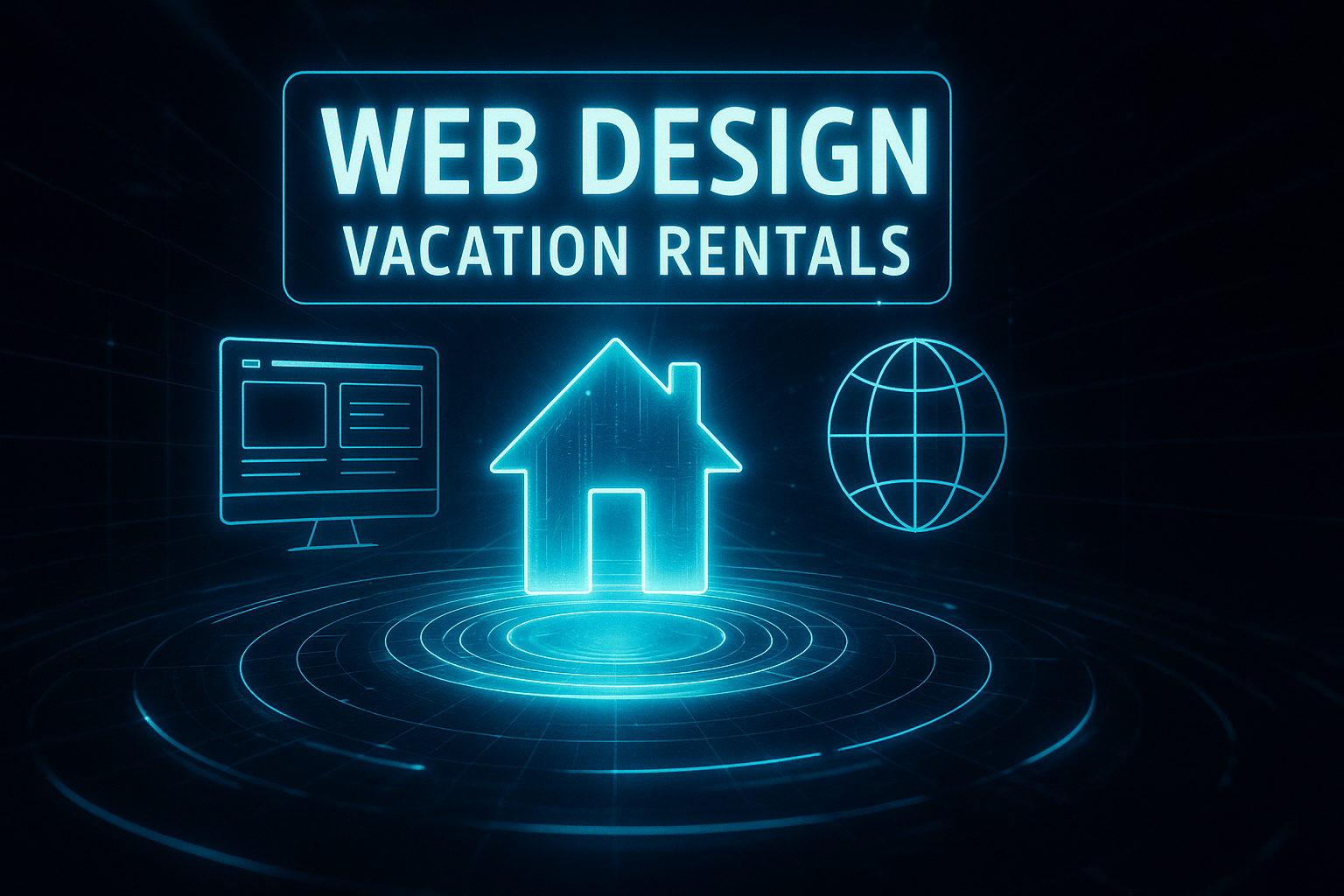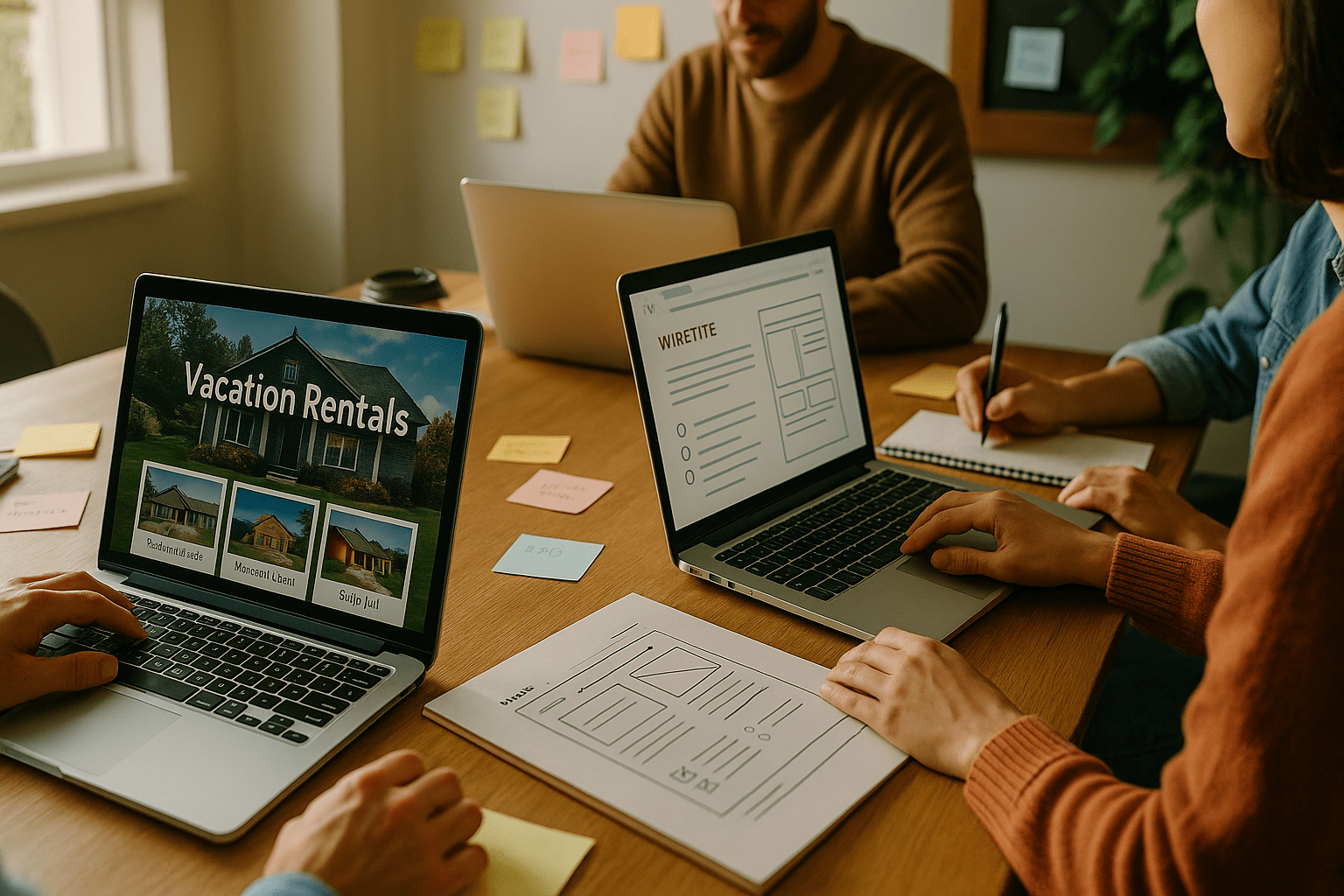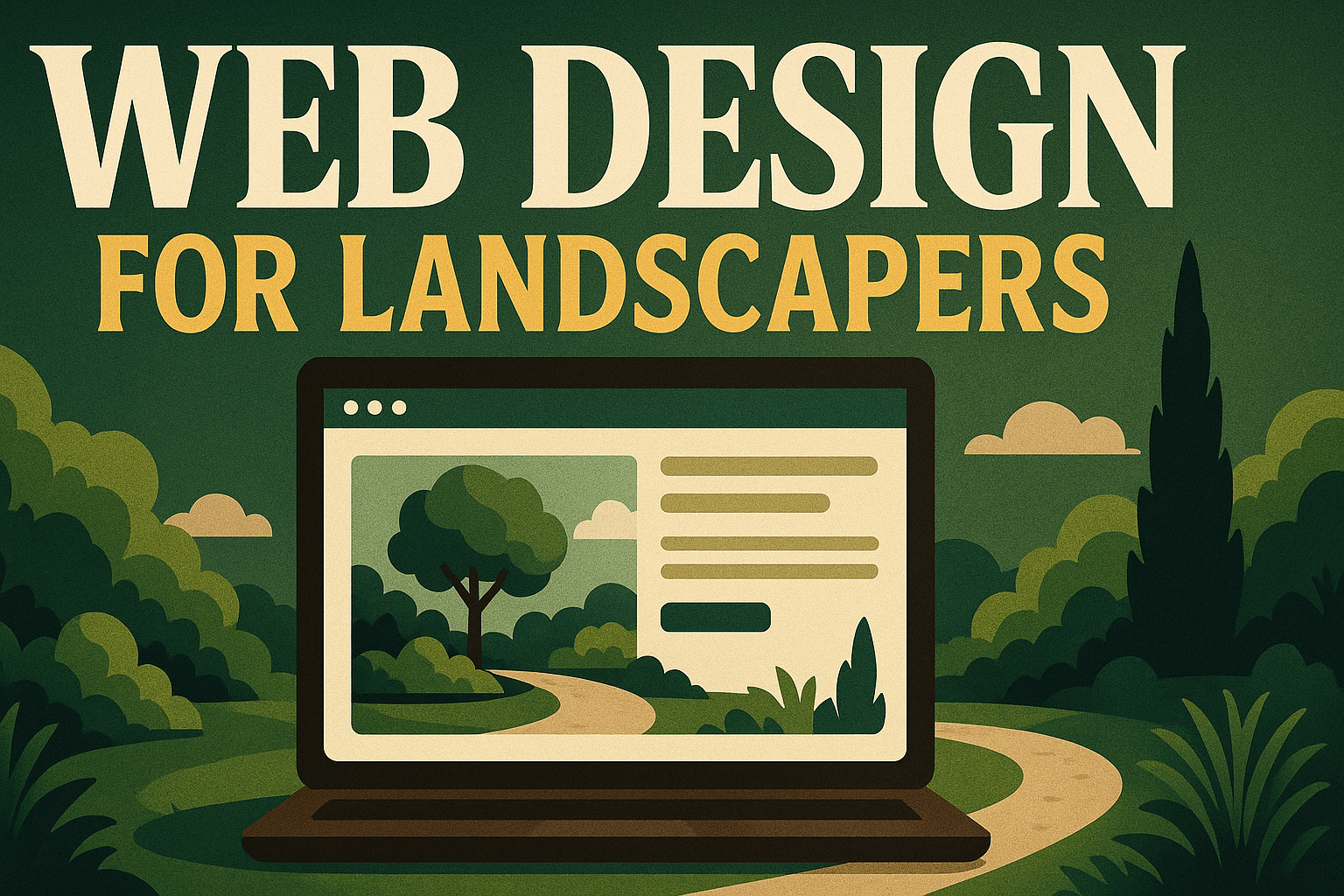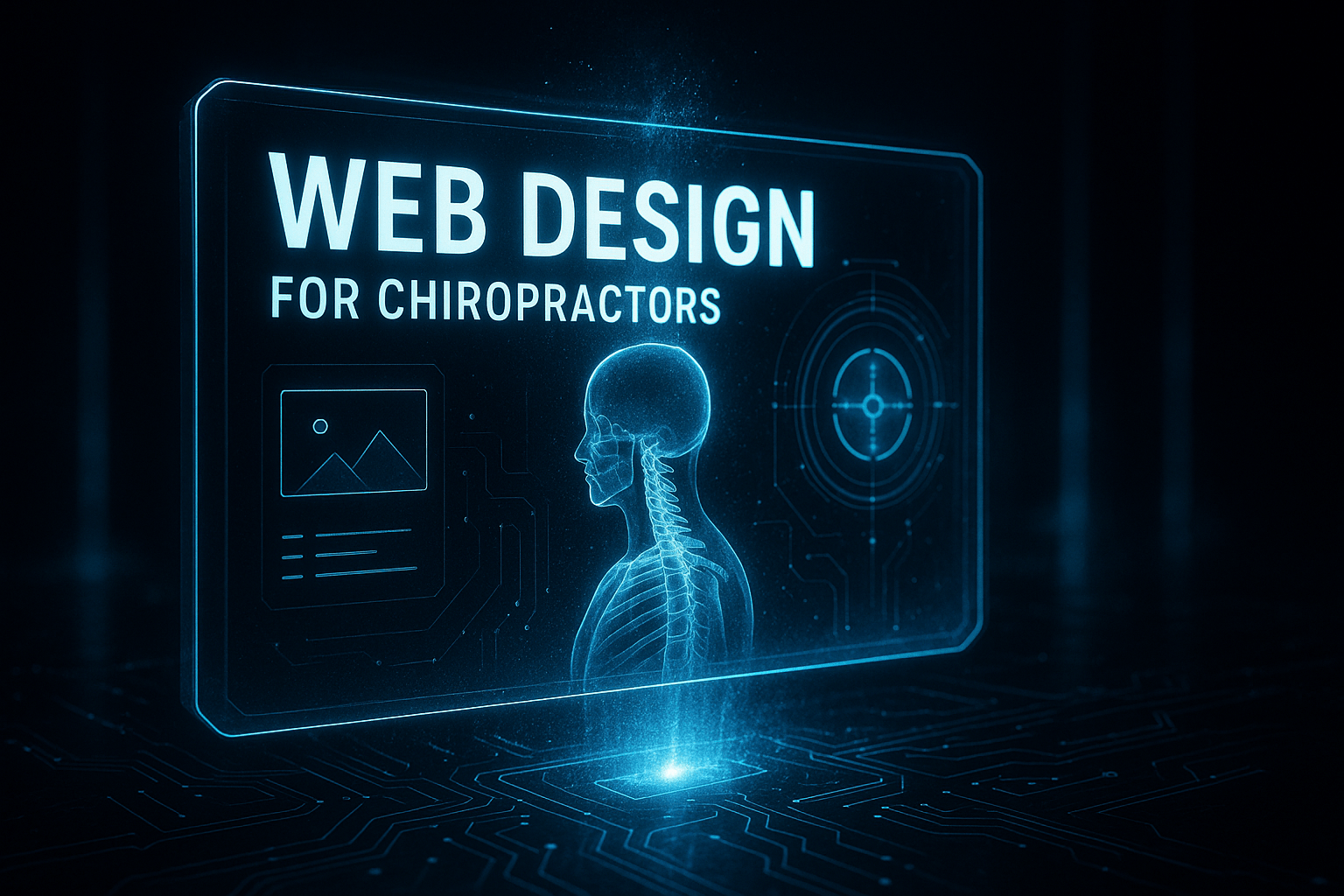Web Design for Vacation Rentals: Complete Guide to Booking-Ready Websites
by Design Delulu Editorial · October 29, 2025

Smart, fast, and measurable. Here's how web design helps vacation rentals win.
Your vacation rental website is more than a digital brochure—it's your most valuable sales asset. While third-party booking platforms charge 15-30% commissions per reservation, a well-designed website drives direct bookings, builds brand equity, and puts you in control of the guest experience from first click to check-out. In a market where travelers compare dozens of properties before booking, your website design determines whether visitors convert into paying guests or click back to Airbnb.
The stakes are high: 68% of vacation rental bookings now start with online research, and properties with professional, mobile-optimized websites see 3-5x higher direct booking rates than those relying solely on listing platforms. Yet most vacation rental websites fail at the fundamentals—slow load times, confusing navigation, missing availability calendars, and checkout flows that abandon guests mid-booking. Strategic web design fixes these friction points while establishing the credibility, convenience, and visual appeal that turn browsers into bookers. Here's your complete roadmap.

Why Vacation Rentals Need Purpose-Built Web Design
Generic website templates fail vacation rentals because they weren't built for the booking journey. Unlike e-commerce or service businesses, vacation rental websites must solve unique challenges: showcasing multiple properties with distinct features, integrating real-time availability and pricing, building trust with first-time guests, and competing against platform giants with billion-dollar marketing budgets.
The vacation rental booking psychology is distinct. Guests aren't buying a commodity—they're investing in an experience, often for significant life moments like family reunions, anniversaries, or milestone celebrations. Your website must deliver emotional resonance alongside practical information. High-quality photography, authentic reviews, detailed amenity descriptions, and local area guides work together to help travelers visualize their stay.
Professional web design addresses three core business objectives:
- Revenue optimization: Reduce platform dependency and commission costs by increasing direct bookings through streamlined reservation flows, calendar integrations, and trust-building elements that convert at 15-25% higher rates than generic sites.
- Operational efficiency: Automate inquiries with FAQ sections, self-service booking tools, and integrated property management systems that reduce manual communication by 40-60%.
- Brand differentiation: Stand out in oversaturated markets by showcasing your unique value proposition, property personality, and guest experience in ways listing platforms don't allow.
The technical requirements are equally important. Vacation rental websites must load in under 2 seconds on mobile devices (where 72% of searches occur), display perfectly across all screen sizes, meet accessibility standards for diverse audiences, and integrate seamlessly with booking engines, channel managers, and payment processors. These aren't optional upgrades—they're baseline expectations that directly impact your bottom line.
Core Components of High-Converting Vacation Rental Websites
Effective vacation rental web design balances aesthetic appeal with conversion mechanics. Every page, image, and interaction should guide visitors toward booking while answering their implicit questions: Is this property right for me? Can I trust this owner? How do I reserve dates?
Homepage: Your 8-Second Pitch
Your homepage has one job: communicate value fast enough to prevent the back button. Lead with your strongest visual—typically an immersive hero image or video showcasing your most photogenic property or amenity. Overlay concise messaging that addresses your ideal guest's primary desire: 'Luxury Lakefront Retreats for Multi-Generation Gatherings' beats generic 'Welcome to Our Rentals.'
Essential homepage elements include:
- Instant availability checker: Prominent date-picker tool that shows real-time openings without forcing navigation to separate pages
- Property showcase: Grid or carousel featuring your portfolio with key details (sleeps 8, pet-friendly, waterfront) and starting prices
- Social proof: Star ratings, review count, and 1-2 testimonial excerpts placed above the fold
- Clear navigation: Obvious pathways to property pages, booking tools, and contact information
- Trust indicators: Professional affiliations, licensing numbers, secure payment badges, and cancellation policies
Avoid common homepage mistakes: auto-playing music, generic stock photos, vague descriptions like 'perfect getaway,' or booking forms that require too much information upfront. Every element should either build trust or reduce friction.
Property Pages: Selling the Experience
Individual property pages do the heavy lifting in your conversion funnel. These pages must balance comprehensive information with scannable layouts—guests want to know everything, but won't read paragraphs.
Photography and media: Showcase 25-40 high-resolution images covering every room, outdoor spaces, amenity close-ups, and surrounding area views. Include 360-degree virtual tours or video walkthroughs for premium properties. Organize galleries by room type or feature category for easy navigation.
Property specifications: Present key details in scannable format:
| Feature Category | Essential Details |
|---|---|
| Accommodations | Bedrooms (with bed types), bathrooms, max occupancy, square footage |
| Amenities | Kitchen equipment, WiFi speed, entertainment systems, climate control |
| Outdoor Features | Deck/patio size, grill type, hot tub, waterfront access, parking spaces |
| Policies | Pet rules, smoking restrictions, event permissions, minimum stay requirements |
| Location | Distance to attractions, airports, restaurants; walkability scores |
Dynamic pricing and availability: Display your calendar with color-coded availability, seasonal rate variations, and clear booking windows. Show nightly rates, cleaning fees, and estimated totals before checkout to prevent cart abandonment.
Reviews and testimonials: Feature property-specific reviews prominently, with filtering by rating, date, and guest type. Respond publicly to all reviews—both positive and negative—to demonstrate engagement and professionalism.
Booking Flow: Removing Friction
The booking process is where most vacation rental websites hemorrhage conversions. Industry data shows 67% of users abandon booking forms due to complexity, unclear pricing, or security concerns.
Optimize your booking flow with:
- Progressive disclosure: Collect information gradually across 2-3 short steps rather than one overwhelming form
- Transparent pricing: Show all costs (base rate, taxes, fees, deposits) before requiring personal information
- Flexible payment options: Accept credit cards, PayPal, and payment plans; display security badges from Stripe, Square, or your payment processor
- Mobile optimization: Ensure form fields are thumb-friendly, autofill-compatible, and error-tolerant on smartphones
- Guest account option: Allow checkout without forced account creation, but offer optional accounts for returning guests
- Instant confirmation: Provide immediate booking confirmation with automated email receipts, property details, and next steps
Test your booking flow quarterly with real users. Time the process, identify abandonment points, and simplify ruthlessly. Every extra field or click costs reservations.

Technical Performance: Speed and Accessibility
Beautiful design means nothing if your site loads slowly or excludes users. Technical performance directly impacts both conversion rates and search rankings—Google prioritizes fast, accessible sites in vacation rental searches.
Core Web Vitals for Vacation Rentals
Largest Contentful Paint (LCP): Your main content should appear within 2.5 seconds. For vacation rentals, this typically means hero images and property listings. Optimize by compressing images to 150KB or less, using modern formats like WebP, implementing lazy loading for below-fold images, and leveraging CDN delivery for media assets.
First Input Delay (FID): Interactive elements (date pickers, booking buttons) must respond within 100 milliseconds. Minimize JavaScript execution time, defer non-critical scripts, and use lightweight frameworks. Test calendar widgets and booking forms specifically—these are your highest-priority interactive elements.
Cumulative Layout Shift (CLS): Prevent content jumping as pages load. Reserve space for images with explicit width/height attributes, load fonts properly to avoid text reflow, and stabilize dynamic content like pricing updates or availability calendars.
Mobile-First Design Imperatives
With 72% of vacation rental searches happening on mobile devices, mobile optimization isn't optional. Design for small screens first, then enhance for tablets and desktops.
Mobile-specific considerations:
- Touch-friendly targets: Buttons and links should be minimum 44x44 pixels with adequate spacing
- Thumb-zone optimization: Place key actions (Book Now, Call, Message) in the bottom third of screens where thumbs naturally rest
- Simplified navigation: Use hamburger menus thoughtfully; expose primary navigation (Properties, Availability, Book) prominently
- Readable typography: Minimum 16px font size for body text, 1.5 line height, high contrast ratios
- Fast image loading: Serve appropriately sized images for mobile screens (750px width maximum), not desktop versions
Accessibility: Expanding Your Audience
WCAG-compliant design isn't just ethical—it's profitable. Accessible websites serve guests with disabilities, elderly travelers, and users with temporary impairments, expanding your addressable market by 15-20%.
Key accessibility practices:
- Semantic HTML: Use proper heading hierarchy (h1 > h2 > h3), descriptive link text ('View 4-bedroom lakehouse' not 'Click here'), and label form fields clearly
- Color contrast: Maintain 4.5:1 ratio for text, 3:1 for large text and UI elements; test with contrast checking tools
- Keyboard navigation: Ensure all booking functions work without a mouse; visible focus indicators on interactive elements
- Alt text: Describe property images meaningfully ('Spacious living room with fireplace and lake views' not 'Living room')
- Screen reader compatibility: Test booking flows with VoiceOver (iOS), TalkBack (Android), or NVDA (Windows)
Content Strategy: Building Trust and SEO Authority
Your website's content serves dual purposes: converting visitors and attracting organic search traffic. Strategic content addresses every stage of the traveler journey while establishing topical authority in your market.
SEO-Optimized Property Descriptions
Property descriptions should target specific search queries while painting vivid pictures. Research actual search terms travelers use: 'pet-friendly cabin Smoky Mountains' or 'beachfront house Outer Banks sleeps 12' have commercial intent and moderate competition.
Structure descriptions with:
- Opening hook: Lead with your unique selling proposition and ideal guest scenario
- Feature-benefit pairs: Don't just list amenities—explain their value ('Chef's kitchen with commercial gas range and island seating for 8, perfect for holiday meal preparation')
- Location context: Include distances and drive times to popular attractions, airports, and necessities
- Seasonal information: Describe what makes your property special year-round
- Natural keyword integration: Weave target terms organically throughout 400-600 word descriptions
Local Area Guides and Resources
Informational content builds authority and captures earlier-stage search traffic. Create comprehensive guides covering:
- Neighborhood overviews: Detailed area descriptions with maps, points of interest, and local character
- Activity guides: Seasonal recommendations for hiking, dining, entertainment, shopping, and family activities
- Practical travel tips: Best times to visit, packing suggestions, driving directions, parking information
- Event calendars: Local festivals, concerts, markets, and seasonal attractions
- Guest preparation: Check-in procedures, house manuals, emergency contacts, WiFi passwords
These resources serve guests pre- and post-booking while ranking for informational searches that introduce your properties to new audiences.
Review Management and Social Proof
Strategic display of reviews builds trust at critical decision moments. Aggregate reviews from multiple sources—your direct bookings, Airbnb, VRBO—to maximize social proof volume. Display recent reviews prominently, feature standout testimonials with guest photos, showcase your overall rating and review count site-wide, and respond to all reviews to demonstrate active management.
Create dedicated testimonial pages that tell guest stories, highlight repeat visitors, showcase specific use cases (family reunions, corporate retreats, wedding groups), and use authentic photos when permitted.

Integration Ecosystem: Connecting Your Tools
Modern vacation rental operations rely on integrated technology stacks. Your website should serve as the central hub connecting booking engines, property management systems, payment processors, and marketing tools.
Essential Integrations
Channel managers: Synchronize availability and rates across your website and listing platforms (Airbnb, VRBO, Booking.com) in real-time to prevent double-bookings and maintain pricing consistency.
Property management systems (PMS): Connect tools like Guesty, Hostfully, or Lodgify to automate guest communication, cleaning schedules, maintenance requests, and financial reporting.
Payment processing: Integrate Stripe, Square, or specialized vacation rental processors for secure transactions, automated deposits, and payment plan options.
Email marketing platforms: Connect Mailchimp, Klaviyo, or ConvertKit to nurture leads, send booking confirmations, deliver pre-arrival instructions, and request post-stay reviews.
Analytics and tracking: Implement Google Analytics 4, Facebook Pixel, and conversion tracking to measure traffic sources, booking attribution, and ROI across marketing channels.
CMS Considerations
Choose a content management system that balances ease-of-use with functionality. Popular options for vacation rentals include:
- WordPress: Maximum flexibility and plugin ecosystem; requires more technical maintenance but unlimited customization
- Webflow: Visual design control with built-in hosting; easier for non-technical users but less extensive integration options
- Specialized vacation rental platforms: Turnkey solutions like Lodgify or BookingSync with industry-specific features but less design flexibility
Prioritize systems that allow you to update availability, pricing, and content without developer assistance. Your team should manage 90% of routine updates independently.
Conversion Rate Optimization: Testing and Iteration
Launch is the beginning, not the end. Systematic testing and optimization compound improvements over time, typically increasing conversion rates 20-40% within the first year.
High-Impact Testing Priorities
Booking flow optimization: Test form length (single page vs. multi-step), field requirements (minimal vs. comprehensive), payment options, and CTA button copy ('Book Now' vs. 'Reserve Your Dates' vs. 'Check Availability').
Pricing presentation: Experiment with displaying nightly rates vs. weekend package pricing, showing discounts prominently vs. standard rates, including fees upfront vs. revealing at checkout, and using dynamic 'only 2 nights left' urgency messages.
Visual hierarchy: Test hero image styles (single striking photo vs. slideshow vs. video), property grid layouts (2-column vs. 3-column, list vs. card view), and CTA button placement and prominence.
Trust elements: Measure impact of review display formats, security badge placement, owner bios and photos, and licensing/certification highlights.
Analytics and Measurement Framework
Track metrics that tie to revenue, not vanity numbers. Your dashboard should monitor:
- Primary metrics: Direct booking conversion rate, average booking value, cost per acquisition, booking-to-inquiry ratio
- Funnel metrics: Property page views, availability checks, booking form starts, form completions, payment success rate
- Traffic quality: Source/medium breakdown, landing page performance, mobile vs. desktop conversion rates, returning visitor booking rate
- Technical health: Page load speeds, error rates, mobile usability scores, search visibility rankings
Review data weekly to spot trends and quarterly for strategic pivots. Focus on improving your worst-performing metric—fixing your biggest leak yields faster gains than optimizing already-strong areas.
Implementation Roadmap: From Strategy to Launch
Effective vacation rental website projects follow a structured process that balances speed with quality. Most engagements run 4-8 weeks depending on property portfolio size and content readiness.
Phase 1: Discovery and Planning (Week 1)
Establish project foundations through stakeholder interviews, competitive analysis, goal setting, and technical requirements gathering. Define your ideal guest personas, booking behavior patterns, revenue targets, and success metrics. Audit your current site (if applicable) to identify what's working and where visitors drop off.
Key deliverables: Project charter, competitive landscape analysis, sitemap and information architecture, measurement framework, and timeline with milestones.
Phase 2: Design and Content (Weeks 2-4)
Create wireframes that map user flows, develop visual design system (colors, typography, component styles), design responsive templates for all page types, and write/edit property descriptions and supporting content.
Prioritize highest-impact pages first: homepage, top 3 properties, and booking flow. Secondary pages (area guides, policies, contact) can launch with simpler designs initially.
Key deliverables: Design system and UI kit, responsive mockups for all templates, property photography (if needed), written content for priority pages, and booking flow prototypes.
Phase 3: Development and Integration (Weeks 4-6)
Build responsive front-end templates, configure CMS for easy content management, integrate booking engine and payment processing, connect channel manager and PMS tools, and implement analytics and conversion tracking.
Use staging environments for development and testing before touching production systems. Test all integrations thoroughly—booking flow bugs directly impact revenue.
Key deliverables: Functional staging site, integrated booking system, CMS training documentation, QA test results, and performance audit.
Phase 4: Launch and Optimization (Weeks 7-8+)
Conduct final QA across devices and browsers, migrate content and data to production, configure DNS and go live, monitor performance and fix issues immediately, and begin testing and optimization cycles.
Plan for 2-4 weeks of post-launch refinement as real user behavior reveals optimization opportunities. Keep a punch list of minor issues and enhancements to address in priority order.
Key deliverables: Live production site, performance monitoring dashboard, optimization testing roadmap, and ongoing support plan.
Ongoing Maintenance and Growth
Websites aren't set-it-and-forget-it assets. Plan for continuous maintenance, content updates, and strategic enhancements that keep your site competitive and conversion rates climbing.
Monthly Maintenance Tasks
Update availability calendars and seasonal rates, refresh homepage hero images seasonally, add new guest reviews and testimonials, check for broken links and fix, monitor site speed and security, update CMS and plugins to latest versions, and review analytics for trends and issues.
Quarterly Strategic Reviews
Analyze booking conversion trends and funnel performance, review competitor websites for new features or positioning, test 2-3 optimization hypotheses, update content to reflect seasonal offerings, assess search rankings and organic traffic, and plan next quarter's enhancements.
Annual Enhancements
Consider major improvements like refreshing visual design to maintain modern aesthetics, adding new property listings or room types, implementing new booking features (payment plans, gift certificates), expanding content library with new area guides, upgrading technical infrastructure for speed/security, and conducting comprehensive UX research with real guests.
Budget and Resource Planning
Professional vacation rental website design typically ranges from $8,000-$35,000 depending on portfolio size, customization needs, and integration complexity. Ongoing costs include hosting ($50-200/month), booking engine subscriptions ($30-100/month per property), maintenance and updates ($500-2,000/month), and content creation/photography ($1,000-5,000 quarterly).
In-house vs. agency considerations: Small operators (1-3 properties) can often manage with template-based solutions and DIY content. Mid-size portfolios (4-10 properties) benefit from professional design with in-house content management. Larger operations (10+ properties) typically need agency partnerships for design, development, and ongoing optimization.
Calculate ROI by comparing your current commission costs on platform bookings to projected increases in direct bookings. Most professional websites pay for themselves within 6-12 months through commission savings alone, before accounting for higher lifetime guest value from direct relationships.
Common Pitfalls to Avoid
Learn from frequent vacation rental website mistakes:
- Platform dependency: Don't treat your website as a secondary channel to Airbnb/VRBO; it's your most profitable booking source when optimized properly
- Information overload: Comprehensive doesn't mean overwhelming; use progressive disclosure to serve details without cluttering pages
- Neglecting mobile: Testing on desktop only is design malpractice; the majority of your traffic uses smartphones
- Set-and-forget mentality: Websites require ongoing optimization; even small monthly improvements compound significantly
- Poor photography: Amateur property photos cost conversions; invest in professional photography or high-quality DIY shots
- Weak CTAs: 'Book Now' buttons should be impossible to miss, consistent across pages, and clear about next steps
- Slow load times: Every extra second costs 7% of conversions; prioritize speed obsessively
- Missing trust signals: Display reviews, licenses, secure payment badges, and owner information prominently
Frequently Asked Questions
Let’s level up your Vacation Rentals business
Need services that actually move the needle for Vacation Rentals? See our approach, pricing, and timelines—then book a quick call.
Additional Resources
- Schedule Your Website Strategy Call
Book a 30-minute consultation to discuss your vacation rental website goals, property portfolio, current challenges, and ideal outcomes. We'll provide tailored recommendations, project scope estimates, and answer all your questions about design, timeline, and investment.
- View Our Vacation Rental Website Portfolio
Explore real examples of high-converting vacation rental websites we've designed. See live case studies, before/after comparisons, conversion rate improvements, and design approaches across different property types and markets.
- Free Vacation Rental Website Tools & Resources
Access our collection of free tools including website audit checklists, conversion rate calculators, SEO keyword planners, mobile optimization tests, and property description templates. Get immediate value while planning your website project.
Related Reading

Discover how strategic web design helps cleaning companies attract customers, showcase services, and convert website visitors into loyal clients. Proven design strategies inside.

Discover proven web design strategies for landscapers in 2026. Learn how to optimize layouts, boost conversions, improve mobile experience, and turn visitors into paying customers.
